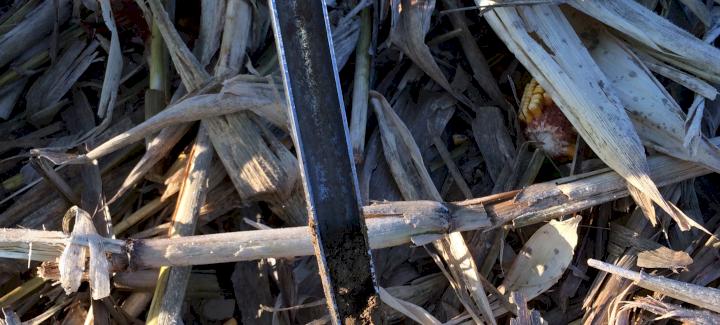
Corn and soybean harvest has kicked off in many areas of the United States. With 12% of the nation’s corn crop and 8% of soybeans harvested, it will be some time before we see the majority of yield results. Until then, growers can look for areas where crops are underperforming. This can indicate a more significant issue within the soil, and fall soil sampling can provide valuable feedback to help ready that ground for the next planting season.
“We always recommend fall soil sampling,” says Tony Lenz, Stine® corn technical agronomist. “While we might not think about soil sampling until after harvest, what growers should be doing now is scouting for areas where crops are struggling and marking those areas, so you know exactly where to go back and conduct a soil sample after harvest. This should also include areas where you detect insect and soybean diseases.”
What areas should be marked?
Scout areas of your field where you suspect yield loss or stunted or damaged plants. If your plants are still green, you may be able to detect nutrient deficiencies. If you have heavy disease or insect pressure, you may notice stalk rot or lodging. Taking note of these areas for post-harvest soil sampling is a good best practice.
“Observe areas where you’re estimating poor yields versus good yields,” says Lenz. “This could include scouting for circular or large areas of down corn or poor stalk quality. In soybeans, check areas where leaves are still attached or where green stems or no pods are an issue. Also, mark areas where insect and disease symptoms are present.”
Lenz also provides tips for how to mark these spots in your field.
“Take pictures from the combine or get out of the combine to take closeup pics of areas of concern in the field,” says Lenz. “You can even pin areas on your combine monitors. It’s also worth calling in an agronomy expert to look at these spots in your field to confirm your findings. If you don’t mark these areas in advance to harvest, it will be a challenge to find them after the crop is out.”
Tips for sampling
The soil sampling process takes time and careful handling. Growers need to consider sample depth, core size, tools used for collecting samples, where to collect samples and even when to collect samples to achieve accurate results. Midwest Laboratories provides some great guidance for soil sampling, but it’s important to keep in mind that best practices can vary from region to region.
“First and foremost, growers need to consult with a local certified soil testing lab or soil testing expert to obtain their recommendations for conducting proper soil sampling,” says Lenz. “Each growing environment has different soil and topography, so the sampling recommendations vary from region to region. You want to ensure you’re doing things correctly to get the most accurate results.”
In addition to consulting a local certified soil testing lab, Tony says growers can also connect with their local extension office, coop or fertilizer supplier for assistance with soil sampling.
Interpreting results
“Once you get the results, it’s important to know what you’re looking for,” says Lenz. “Macronutrients, micronutrients, soil pH, CEC levels and more are calculated by soil sampling labs. It’s important to look at all of these levels together as a whole and understand how these elements work together in your soil. This will paint the best picture of what you need for nutrients in your field next year.”
Some things to consider: If you had a high-yielding crop come out of your ground, it may have removed a lot of key nutrients necessary to help next year’s crop thrive. On the flip side, if you were in a drought area and had lower-than-anticipated yield results, you may not have removed as many nutrients as expected. In either scenario, you need to know where your levels are at to determine if inputs are needed. It may be that you do not need to add nutrients, and with the high price of inputs, that could save you money. You also want to make sure your soil pH is balanced. This article from 2021 highlights what nutrients are tested and ideal ranges for pH and CEC levels.
“Soil experts can help you interpret the results of your soil sample,” says Lenz. “They can also help you establish a fertility management plan for the next growing season.”
Why sample this fall vs. next spring?
Experts at Ohio State University Extension’s Agronomic Crops Network say, “Many producers find that fall is an ideal time to sample soil for several reasons: 1) soils often have an ideal moisture range that makes sampling easy, 2) it gives producers ample time to apply fertilizer or lime before the next crop and 3) it helps ensure spring planting will not be delayed.”
We agree. Growers tend to have more availability after harvest versus in the busy spring planting season. Getting ahead of your fertility management plans will free up time come spring and allow those nutrients to settle in before a deep winter freeze.
For more information on soil sampling and what to look for, reach out to your local Stine sales rep or regional sales agronomist.
Related Articles
-

Stine® to offer Syngenta’s Victrato® soybean seed treatment in 2026
December 2025 in Agronomy
-

Use Stine’s XP® seed treatments to prevent early injury to your crops
December 2025 in Agronomy
-

Understanding Stine’s enhanced oil profile soybeans
December 2025 in Agronomy
-

Soil sampling sets the stage for spring
November 2025 in Agronomy



